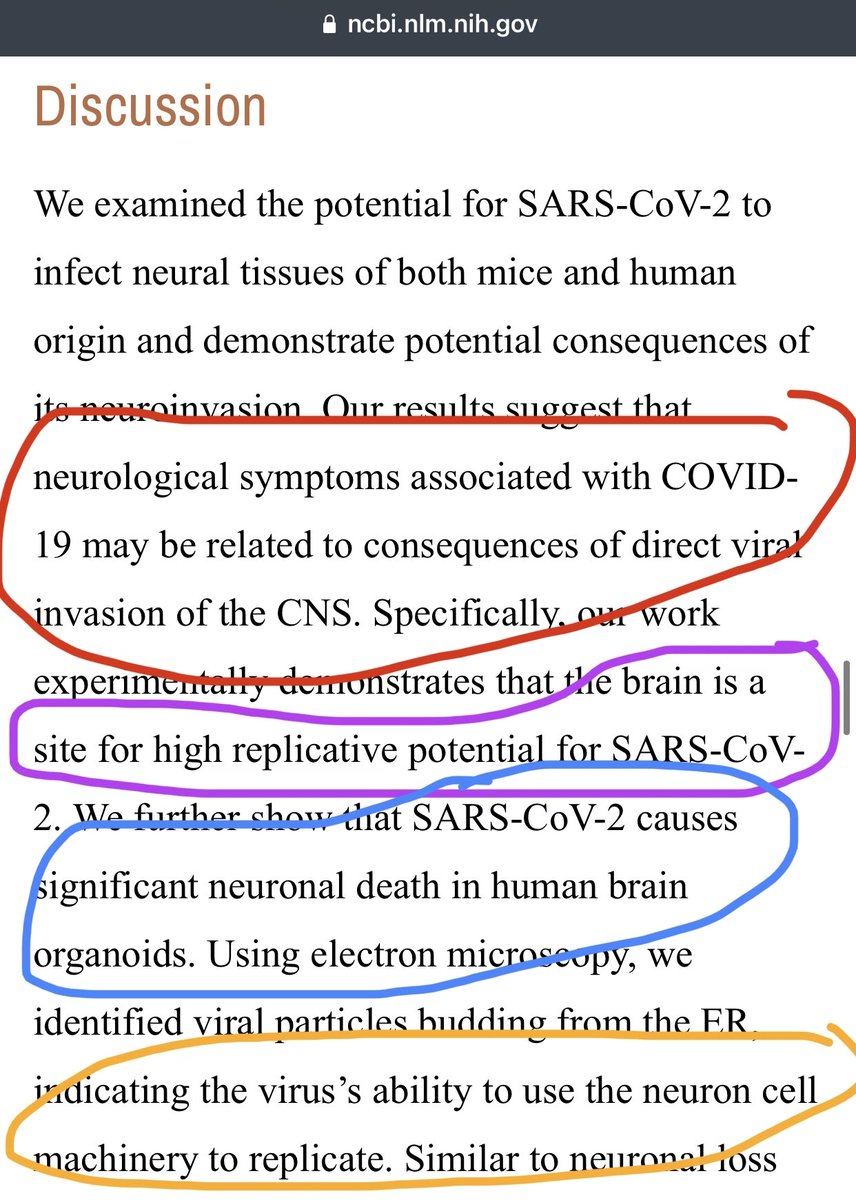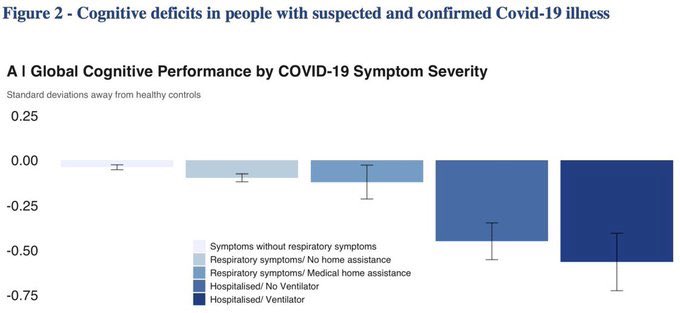Does neuroinvasion of the brain by #SARSCoV2 happen? Not just in mice, but in *humans*? The clear answer in this study is yes — both demonstrated with human brain cells and brain  inspection of deceased #COVID19 patients.
inspection of deceased #COVID19 patients.  from a peer reviewed paper.
from a peer reviewed paper.
https://www.ncbi.nlm.nih.gov/pmc/articles/PMC7808299/
 inspection of deceased #COVID19 patients.
inspection of deceased #COVID19 patients.  from a peer reviewed paper.
from a peer reviewed paper.https://www.ncbi.nlm.nih.gov/pmc/articles/PMC7808299/
2) Let’s first read the abstract:
 ”using human brain organoids... clear evidence of infection”
”using human brain organoids... clear evidence of infection”
 ”neuroinvasion can be blocked”
”neuroinvasion can be blocked”
 ”in autopsies of patients who died of COVID19... we detect #SARSCoV2 in neurons”
”in autopsies of patients who died of COVID19... we detect #SARSCoV2 in neurons”
 ”neuroinvasive capacity of #SARSCoV2”
”neuroinvasive capacity of #SARSCoV2”
 ”using human brain organoids... clear evidence of infection”
”using human brain organoids... clear evidence of infection” ”neuroinvasion can be blocked”
”neuroinvasion can be blocked” ”in autopsies of patients who died of COVID19... we detect #SARSCoV2 in neurons”
”in autopsies of patients who died of COVID19... we detect #SARSCoV2 in neurons” ”neuroinvasive capacity of #SARSCoV2”
”neuroinvasive capacity of #SARSCoV2”
3) Conclusions from main discussion summary:
 ”results suggest that neurological symptoms associated with COVID-19 may be related to consequences of direct viral invasion of the central nervous system”
”results suggest that neurological symptoms associated with COVID-19 may be related to consequences of direct viral invasion of the central nervous system”
 ”brain is a site for high replicative potential for SARS-CoV-2.”
”brain is a site for high replicative potential for SARS-CoV-2.”
 ”results suggest that neurological symptoms associated with COVID-19 may be related to consequences of direct viral invasion of the central nervous system”
”results suggest that neurological symptoms associated with COVID-19 may be related to consequences of direct viral invasion of the central nervous system” ”brain is a site for high replicative potential for SARS-CoV-2.”
”brain is a site for high replicative potential for SARS-CoV-2.”
5) “Using electron microscopy, we identified viral particles budding from the ER, indicating the virus’s ability to use the neuron cell machinery to replicate”
6) “possible that viral infection induces locally hypoxic regions, which aids in lowering the threshold for tissue damage in the context of an already oxygen-deprived state.”
7) Bottomline—in both human cells and #COVID19 patients, they found #SARSCoV2 was not only present but also able to infect, replicate and show damage to neurons. It’s clear there is potential for neuroinvasion of this virus.
8) also worrisome study—cognitive decline in recovered #COVID19 patients was found across severity level—largest among those hospitalized (& also among those not hospitalized). How big decline in hospitalized patients? Equal to -8.5 IQ point drop says @AliNouriPhD.
9) Decline was more pronounced for tests that assessed problem solving & visual attention. Study controlled for age, gender, education, income, racial-ethnic group & pre-existing conditions. https://www.medrxiv.org/content/10.1101/2020.10.20.20215863v1
10) Another study in mice— “direct infection of CNS cells together with the induced inflammatory response in the brain resulted in the severe disease observed in SARS-CoV-2-infected (transgenic) mice.” https://www.mdpi.com/1999-4915/13/1/132/htm
11) “highest virus titers in lungs observed on day 3 and declined on days 5 and 6. By contrast, very high levels of infectious virus were uniformly detected in the brains on days 5 and 6. Onset of severe disease in infected mice correlated with peak viral levels in the brain.”
12) “SARS-CoV-2-infected mice exhibited encephalitis hallmarks.
SARS-CoV-2 was also found to productively infect cells within the nasal turbinate, eye and olfactory bulb, suggesting SARS-CoV-2 entry into the brain by this route after intranasal infection.”
SARS-CoV-2 was also found to productively infect cells within the nasal turbinate, eye and olfactory bulb, suggesting SARS-CoV-2 entry into the brain by this route after intranasal infection.”
13) OVERALL—this can explain why we see serious #LongCovid symptoms related to cognitive illnesses. https://twitter.com/drericding/status/1326038189971288064

 Read on Twitter
Read on Twitter






